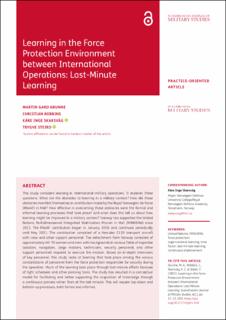| dc.contributor.author | Grunne, Martin | |
| dc.contributor.author | Robbins, Christian | |
| dc.contributor.author | Skarsvåg, Kåre Inge | |
| dc.contributor.author | Steiro, Trygve Jakobsen | |
| dc.date.accessioned | 2023-09-12T05:46:02Z | |
| dc.date.available | 2023-09-12T05:46:02Z | |
| dc.date.created | 2023-04-23T20:10:49Z | |
| dc.date.issued | 2023 | |
| dc.identifier.citation | Scandinavian Journal of Military Studies. 2023, 6 (1), 11-23. | en_US |
| dc.identifier.issn | 2596-3856 | |
| dc.identifier.uri | https://hdl.handle.net/11250/3088745 | |
| dc.description.abstract | This study considers learning in international military operations. It explores these questions: What are the obstacles to learning in a military context? How did these obstacles manifest themselves in contribution made by the Royal Norwegian Air Force (RNoAF) in Mali? How effective in overcoming these obstacles were the formal and informal learning processes that took place? And what does this tell us about how learning might be improved in a military context? Norway has supported the United Nations Multidimensional Integrated Stabilization Mission in Mali (MINUSMA) since 2013. The RNoAF contribution began in January 2016 and continued periodically until May 2021. The contribution consisted of a Hercules C130 transport aircraft with crew and other support personnel. The detachment from Norway consisted of approximately 60–70 women and men with backgrounds in various fields of expertise (aviators, navigators, cargo masters, technicians, security personnel, and other support personnel) required to execute the mission. Based on in-depth interviews of key personnel, this study looks at learning that took place among the various constellations of personnel from the force protection responsible for security during the operation. Much of the learning took place through last-minute efforts because of tight schedules and other pressing tasks. The study has resulted in a conceptual model for facilitating and better supporting the acquisition of knowledge through a continuous process rather than at the last minute. This will require top-down and bottom-up processes, both formal and informal | |
| dc.description.abstract | Learning in the Force Protection Environment between International Operations: Last-Minute Learning | |
| dc.language.iso | eng | en_US |
| dc.rights | Navngivelse 4.0 Internasjonal | * |
| dc.rights.uri | http://creativecommons.org/licenses/by/4.0/deed.no | * |
| dc.title | Learning in the Force Protection Environment between International Operations: Last-Minute Learning | en_US |
| dc.title.alternative | Learning in the Force Protection Environment between International Operations: Last-Minute Learning | en_US |
| dc.type | Peer reviewed | en_US |
| dc.type | Journal article | en_US |
| dc.description.version | publishedVersion | |
| dc.source.pagenumber | 11-23 | en_US |
| dc.source.volume | 6 | en_US |
| dc.source.journal | Scandinavian Journal of Military Studies | en_US |
| dc.source.issue | 1 | en_US |
| dc.identifier.doi | 10.31374/sjms.148 | |
| dc.identifier.cristin | 2142694 | |
| cristin.ispublished | true | |
| cristin.fulltext | original | |
| cristin.qualitycode | 1 | |

